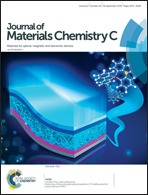Ionic effects on the self-assembly, molecular dynamics and conduction properties of a 1,2,3-triazole-based amphiphile†
Abstract
In this paper, we report on the self-assembly, molecular dynamics, and ionic conduction properties of an amphiphile (1) and its ionic counterparts. The amphiphile consists of an ionophobic (dodecyl periphery with an aromatic core) part and an ionophilic tri(ethylene oxide) (TEO) part. In contrast to 1, which lacks the liquid crystalline (LC) phase, the ionic samples exhibit disordered and hexagonal columnar phases (Coldis and Colhex, respectively) composed of ionophobic cylinders surrounded by a continuous ionophilic matrix. Infrared (IR) and dielectric relaxation spectroscopy (DRS) data indicate that the hydrogen bonding interactions of the triazolyl groups are weakened by the coordination of triazolyl nitrogen atoms with lithium ions. Thus, the molecular reorientation of the ionic samples is facilitated in comparison to 1. In addition, the Coldis of 1-0.1 ([Li+]/[EO] = 0.1) shows faster molecular reorientation than the Colhex of 1-0.2 ([Li+]/[EO] = 0.2) over the same temperature range, indicating the influence of structural order. The ionic conduction properties are determined by complex impedance and electric modulus analyses. The triazolyl groups in the ionophobic region also contribute to ionic conduction along with the TEOs in the ionophilic region. Remarkably, the temperature-dependent impedance data clearly reflect the Coldis-to-Liq phase transition, which cannot be identified by optical techniques. In the liquid (Liq) phase, the two conducting components homogenize. The conductivity values of 1-0.1 are somewhat higher than those of 1-0.2 in the LC phases due to the superior structural flexibility of the former, but the values converge in the Liq phase. Consequently, the addition of lithium salt to the triazole-based amphiphile significantly affects the thermal, self-assembly, molecular dynamics and ionic conduction properties.



 Please wait while we load your content...
Please wait while we load your content...